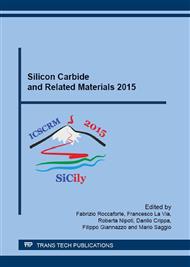p.197
p.201
p.205
p.209
p.213
p.217
p.221
p.225
p.229
Structure of Straight-Line Defect and its Effect on the Electrical Properties of Schottky Barrier Diodes
Abstract:
We have investigated the “straight-line defect,” which has not been classified separately and is quite similar to the carrot defect. We found that the straight-line defect differed structurally from the carrot defect. The presence of a particle on the substrate-epi layer interface seemed to be the cause of the defect; a layer of poly-type (3C-SiC) extended from the particle to the epi-layer surface. The straight-line defect likely resulted from shape change from the 3C-SiC triangular defect. This change in shape from triangular to straight-line defects depended on the C/Si ratio. To investigate the electrical characteristics, we fabricated a Schottky barrier diode (SBD) structure on a silicon carbide (SiC) epi wafer. With application of a high voltage, destruction occurred on both the upstream and the downstream side of the step flow of straight-line defects in the reverse voltage test. This reverse direction characteristic differed from that observed with triangular defects.
Info:
Periodical:
Pages:
213-216
Citation:
Online since:
May 2016
Authors:
Price:
Сopyright:
© 2016 Trans Tech Publications Ltd. All Rights Reserved
Share:
Citation:


